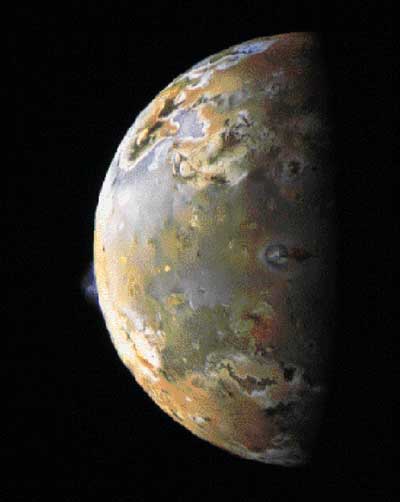 |
Contributing to the constant emissio n of sulfurous gas that fuels a powerful electrical circuit between Jupiter  and its volcanic moon, two sulfurous eruptions are visible on io in this color composite image from the Galileo spacecraft. On the far left, a bluish plume rises about 85 miles above the surface of a volcanic caldera called Pillan Patera. In the middle of the image, near the day/night shadow line, the ring-shaped Prometheus plume rises 45 miles above io and casts a shadow to the right of the volcanic vent. The Prometheus plume has been visible in every image made of this region, dating back to the Voyager flybys of 1979, raising the possibility that this volcano has been continuously active for at least 20 years. and its volcanic moon, two sulfurous eruptions are visible on io in this color composite image from the Galileo spacecraft. On the far left, a bluish plume rises about 85 miles above the surface of a volcanic caldera called Pillan Patera. In the middle of the image, near the day/night shadow line, the ring-shaped Prometheus plume rises 45 miles above io and casts a shadow to the right of the volcanic vent. The Prometheus plume has been visible in every image made of this region, dating back to the Voyager flybys of 1979, raising the possibility that this volcano has been continuously active for at least 20 years. |
When too many electrons build up in one spot, the resulting forces can create a channel of electrically charged gas--a plasma  . An electric current will immediately spark through the plasma . An electric current will immediately spark through the plasma  to relieve the imbalance. You don't mind feeling that shock when you touch a car door or your dog's nose, but you'd prefer not to ignite a spark on your computer's circuit board. The strongest naturally occurring sparks are considerably more hazardous. Billio to relieve the imbalance. You don't mind feeling that shock when you touch a car door or your dog's nose, but you'd prefer not to ignite a spark on your computer's circuit board. The strongest naturally occurring sparks are considerably more hazardous. Billio  ns of tiny ice particles rub together to produce electron imbalances within storm clouds. When the electrons arc to another cloud or to the ground, we call the spectacular discharge lightning ns of tiny ice particles rub together to produce electron imbalances within storm clouds. When the electrons arc to another cloud or to the ground, we call the spectacular discharge lightning  . Our salty fluids make our bodies good electrical conductors. As a result, plasma . Our salty fluids make our bodies good electrical conductors. As a result, plasma  channels often connect to someone's head--or the upraised club of a careless golfer--to launch the discharge. channels often connect to someone's head--or the upraised club of a careless golfer--to launch the discharge.
These fatal shocks on Earth pale next to those on Jupiter  and Saturn and Saturn  , where thunderclouds are thousands of times larger. lightning , where thunderclouds are thousands of times larger. lightning  bolts from the gas giant planets would devastate entire cities if they struck here. The system of satellites around Jupiter bolts from the gas giant planets would devastate entire cities if they struck here. The system of satellites around Jupiter  hosts an even more impressive electrical display. The volcanic moon io hosts an even more impressive electrical display. The volcanic moon io  ejects sulfurous gas into space. This charged material circles Jupiter ejects sulfurous gas into space. This charged material circles Jupiter  in an enormous torus--a doughnut-shaped region laced with magnetic fields. As io in an enormous torus--a doughnut-shaped region laced with magnetic fields. As io  orbits Jupiter orbits Jupiter  and passes through the torus, a current flows between them. Carrying about 2 trillion watts, it's the most powerful electrical circuit in the solar system, save for those on the Sun. The current creates bright auroras near Jupiter and passes through the torus, a current flows between them. Carrying about 2 trillion watts, it's the most powerful electrical circuit in the solar system, save for those on the Sun. The current creates bright auroras near Jupiter  's poles and makes the environment near io 's poles and makes the environment near io  dangerous for spacecraft. dangerous for spacecraft.
Smaller electric currents course through Earth's interior and, to varying degrees, the interiors of other planets. Earth contains an iron core  , as well as minerals near the surface that are susceptible to electromagnetic forces. Iron within the molten outer core flows readily, while slow stirrings in the overlying rock carry material toward and away from the core. This drives a weak but large-scale electric current. The exact mechanism still isn't clear, but, as Oersted showed, moving electric fields spawn (continued) , as well as minerals near the surface that are susceptible to electromagnetic forces. Iron within the molten outer core flows readily, while slow stirrings in the overlying rock carry material toward and away from the core. This drives a weak but large-scale electric current. The exact mechanism still isn't clear, but, as Oersted showed, moving electric fields spawn (continued)
|

